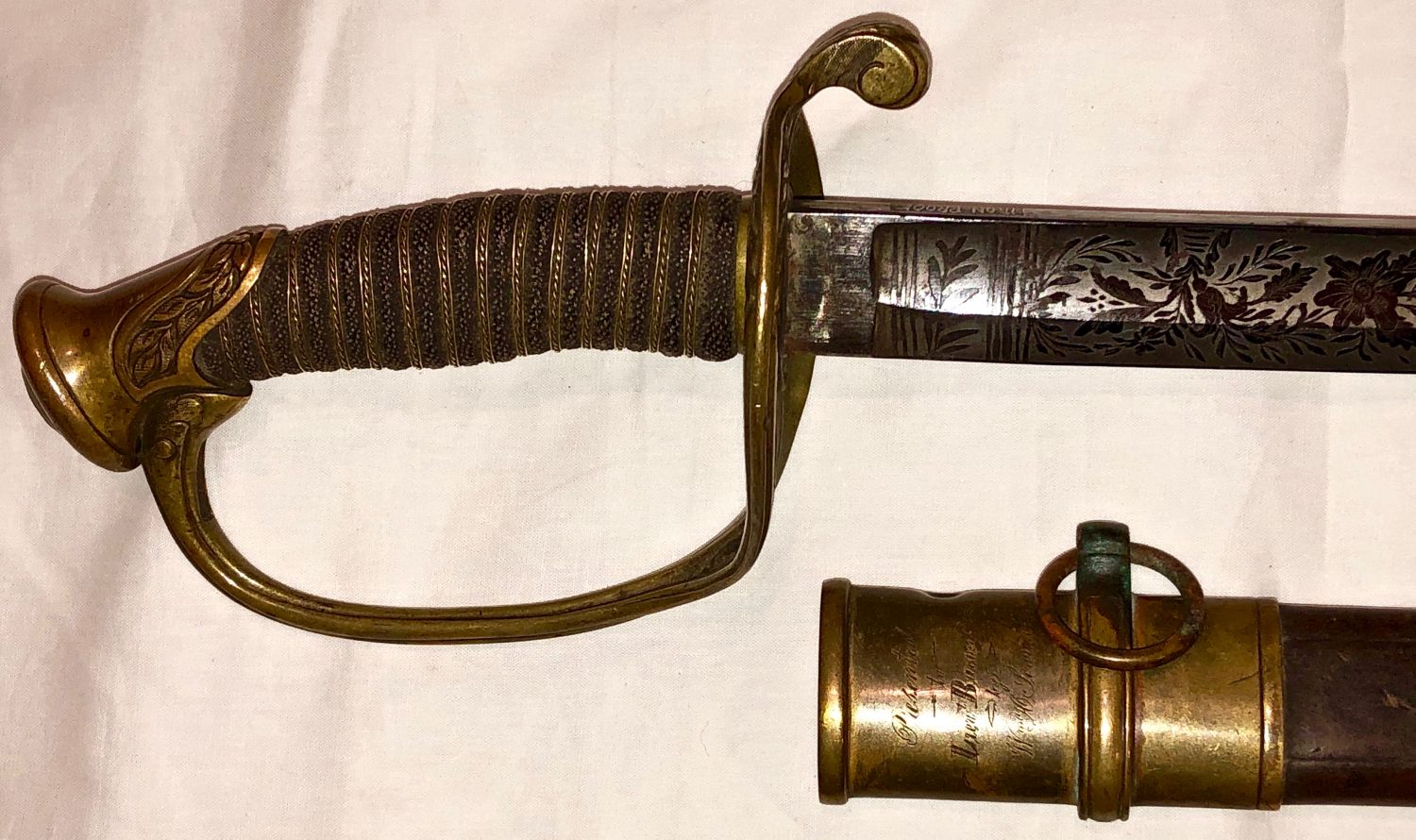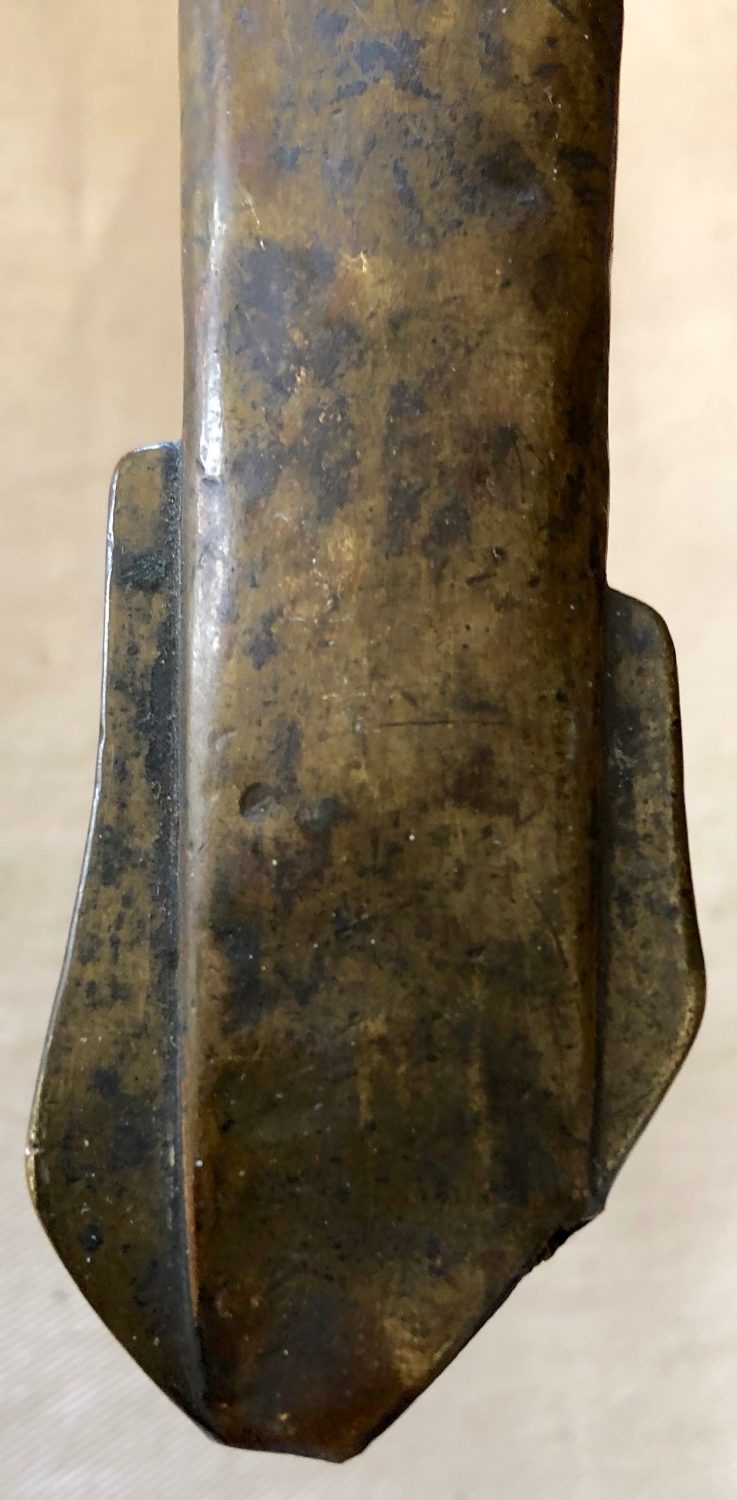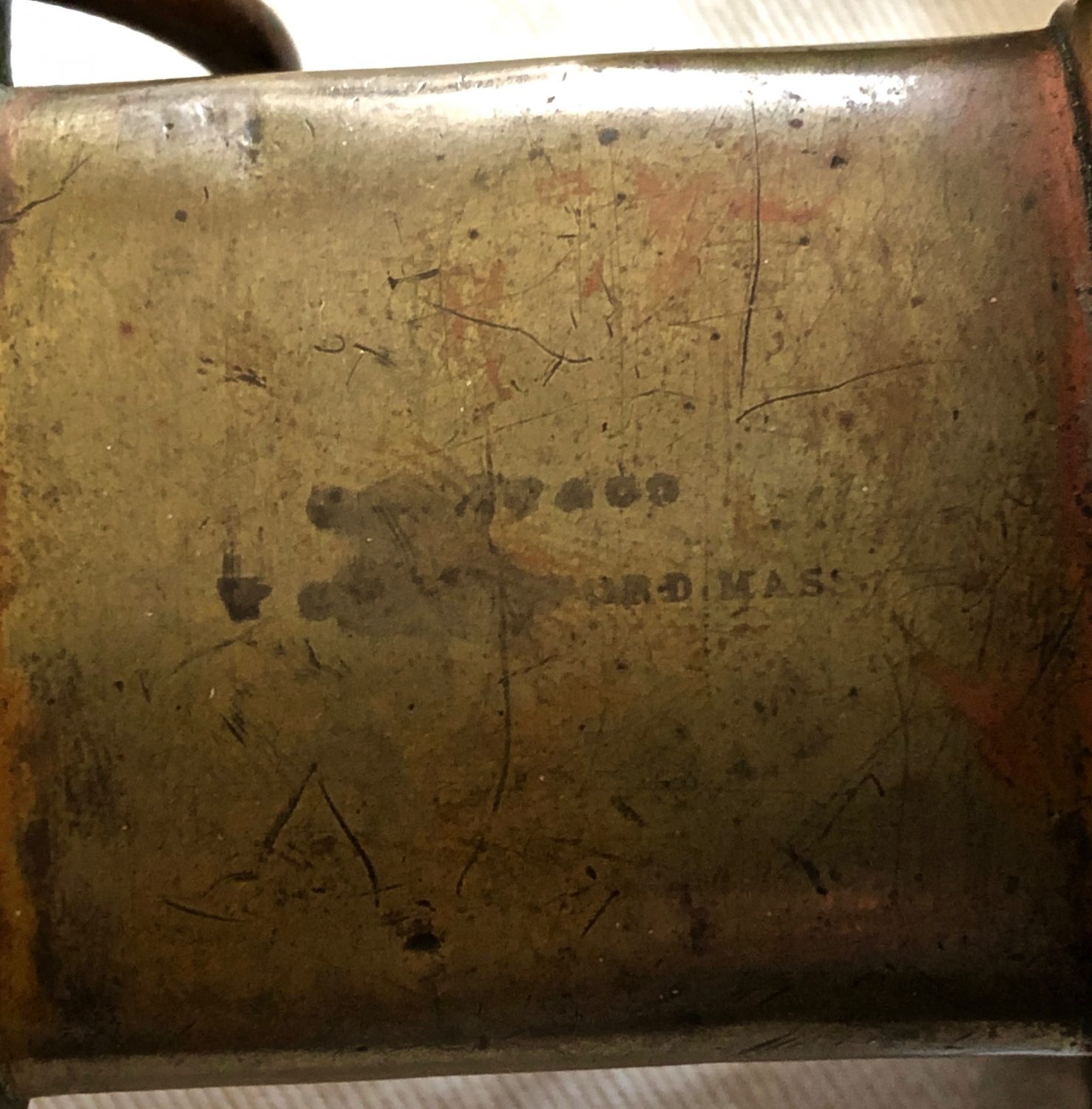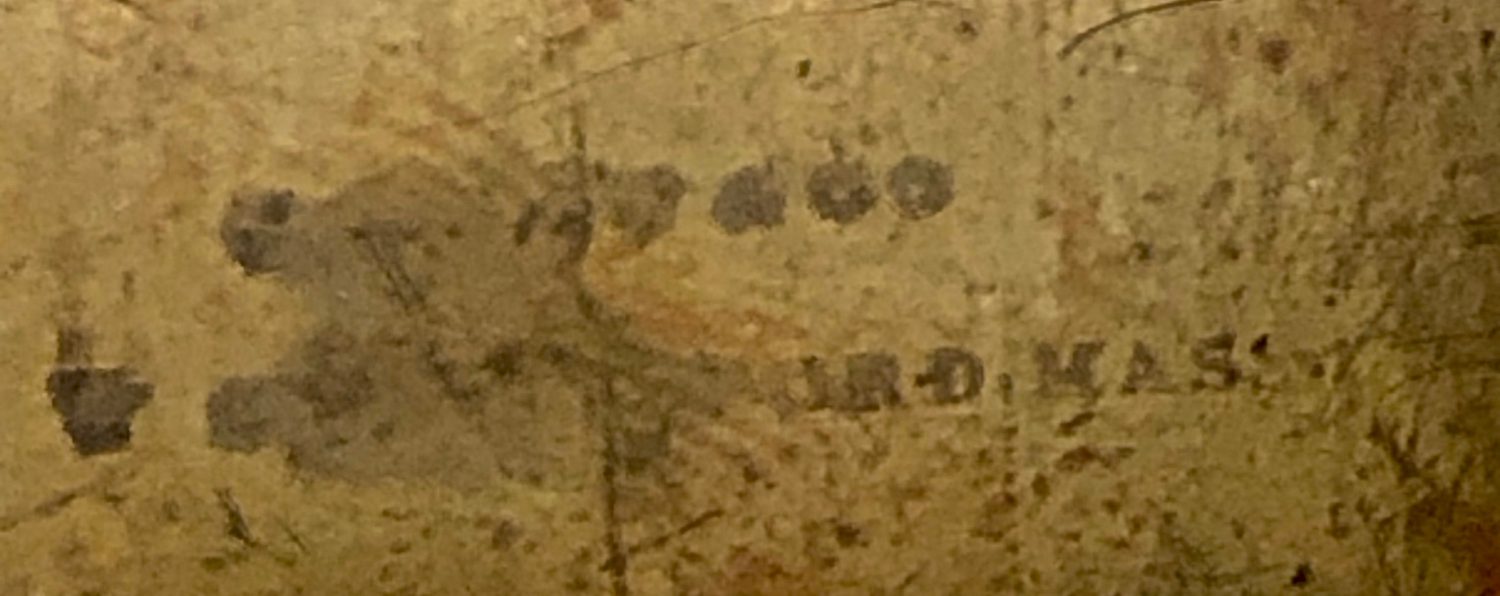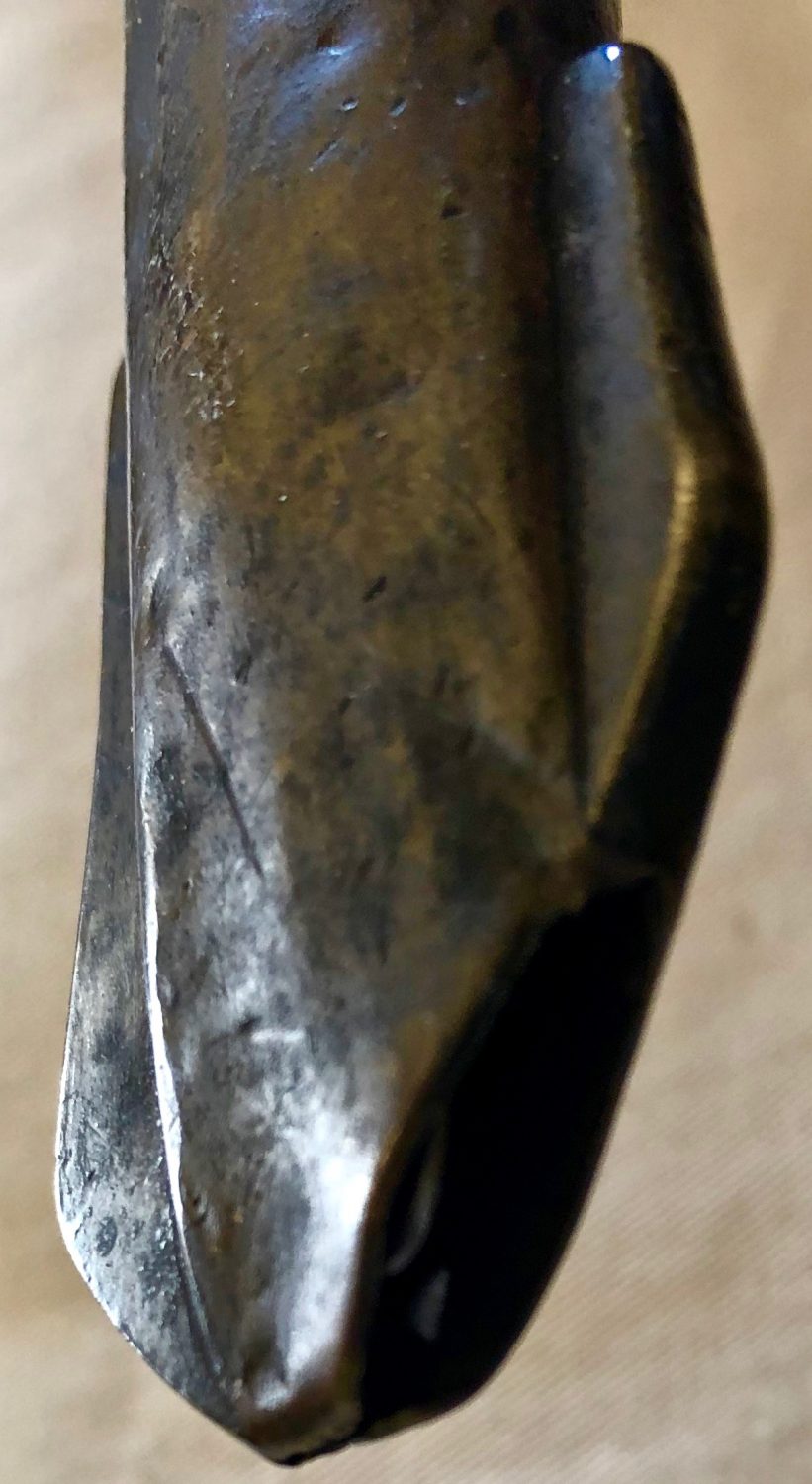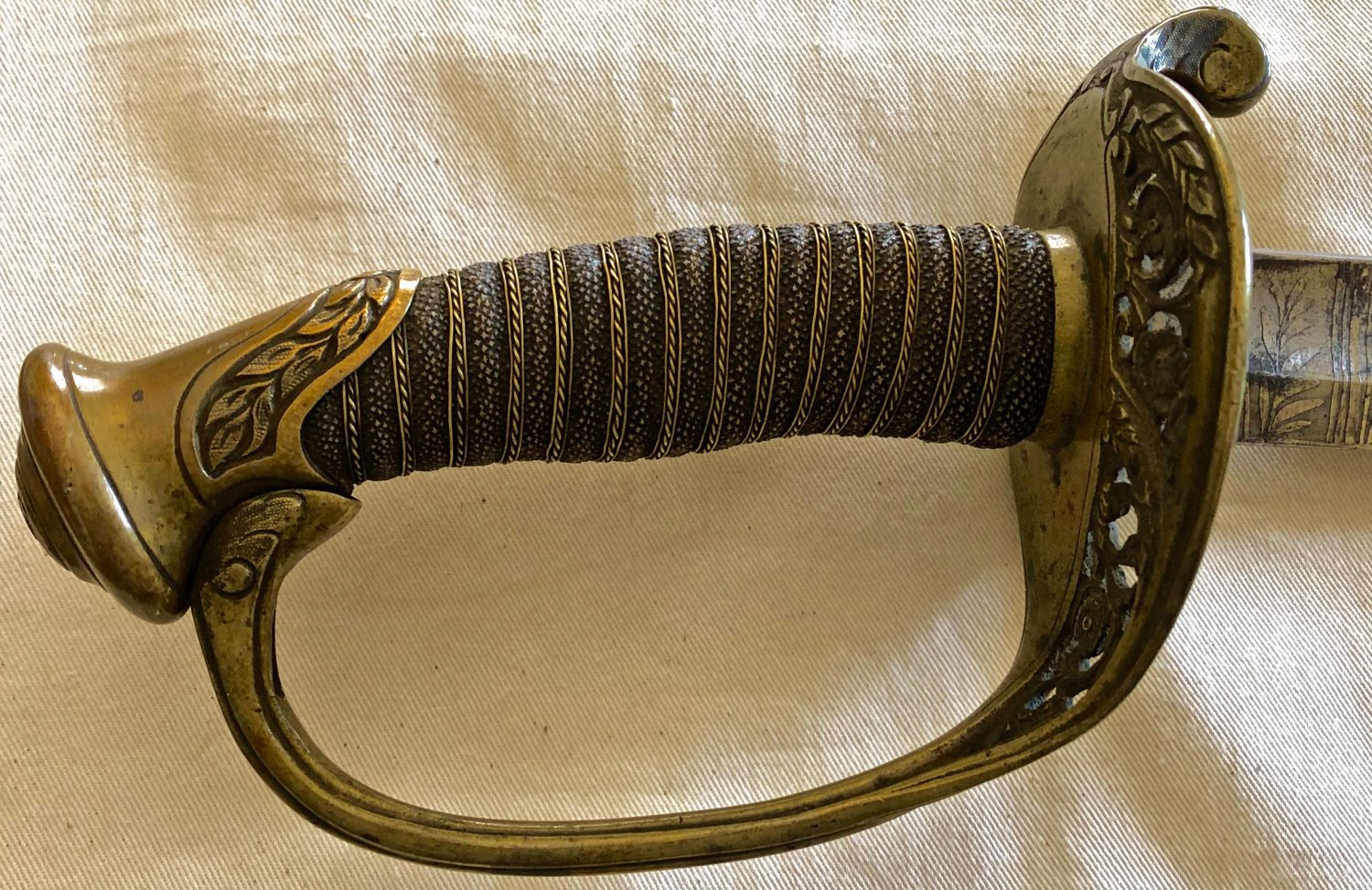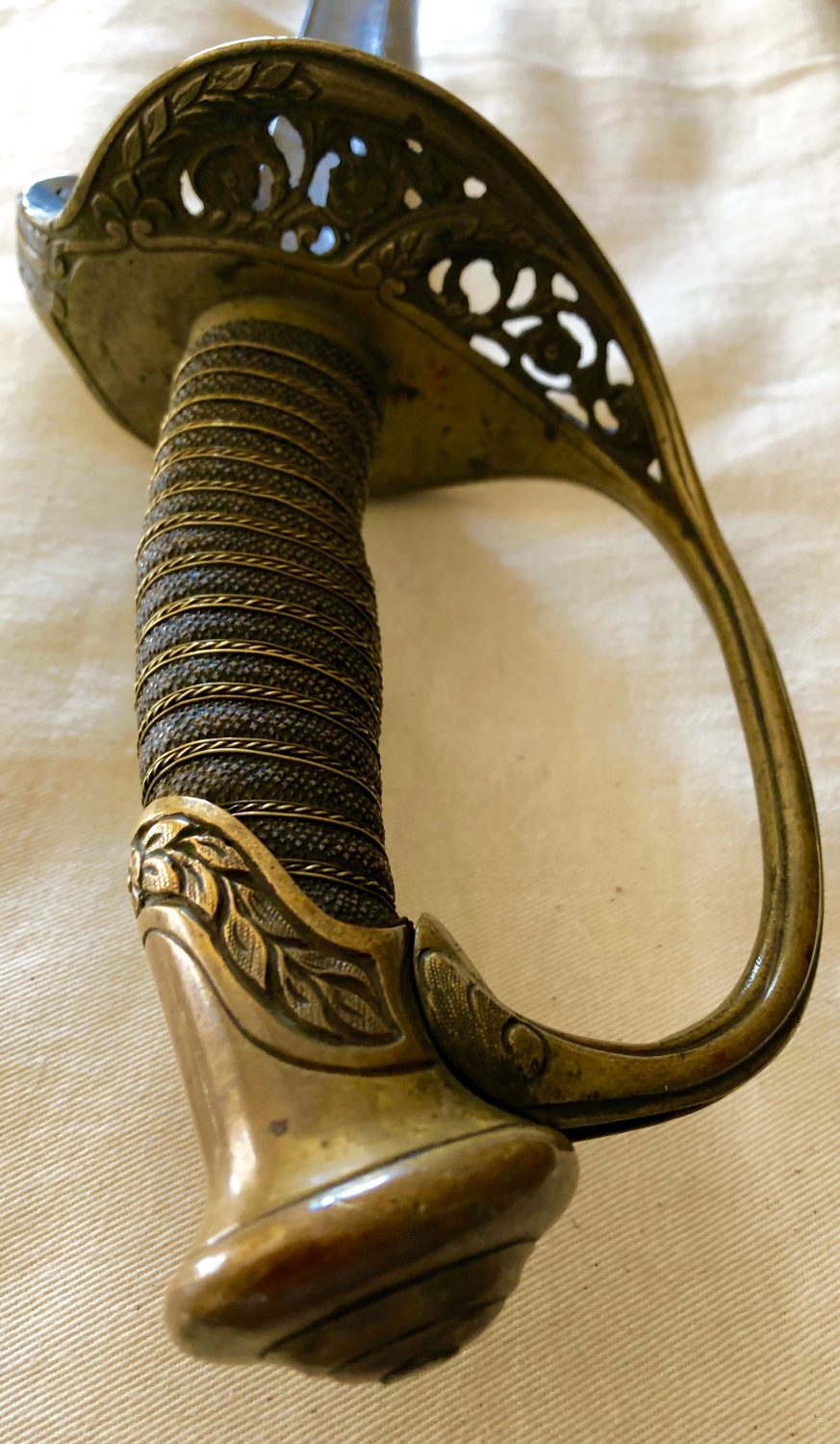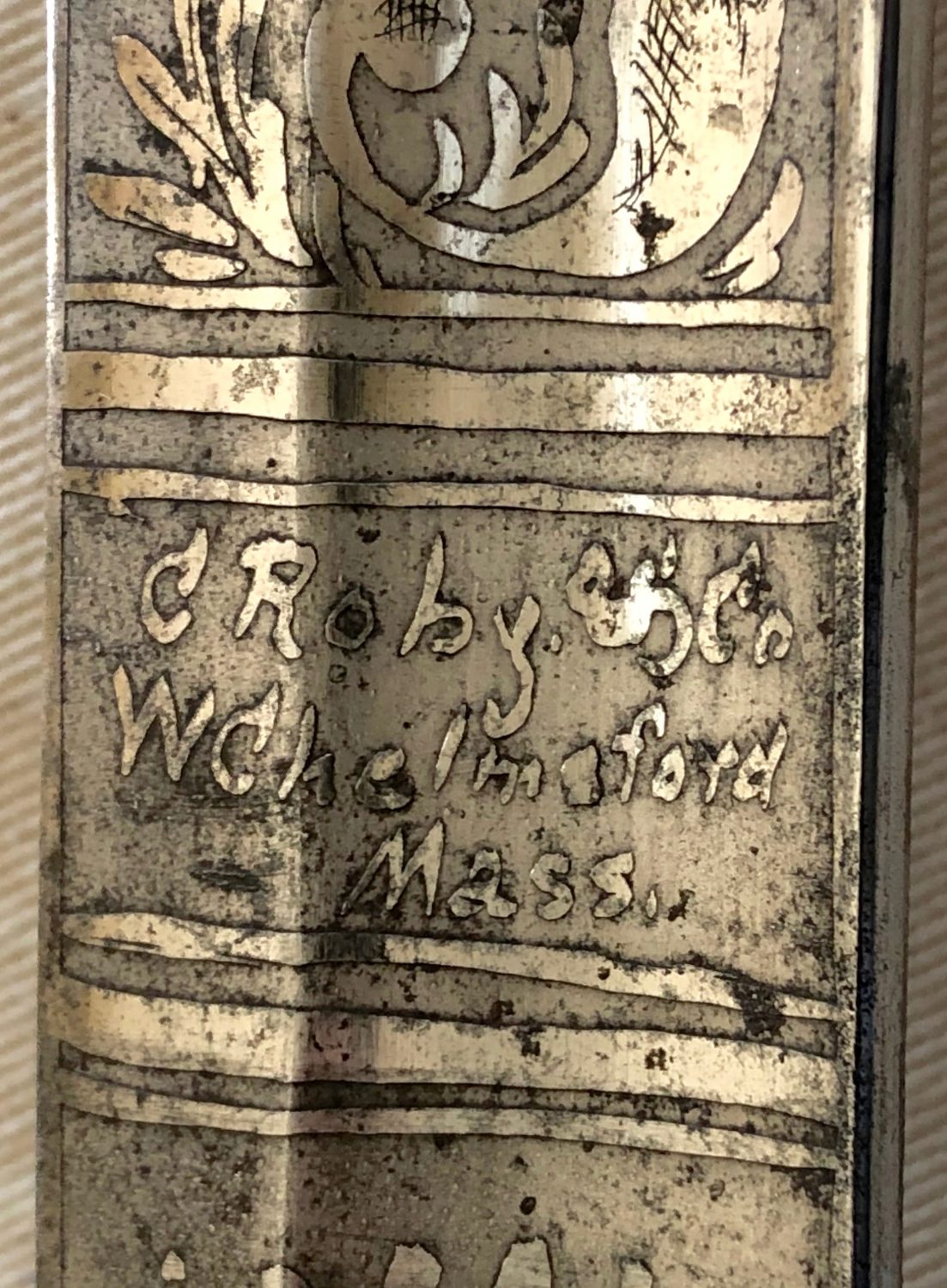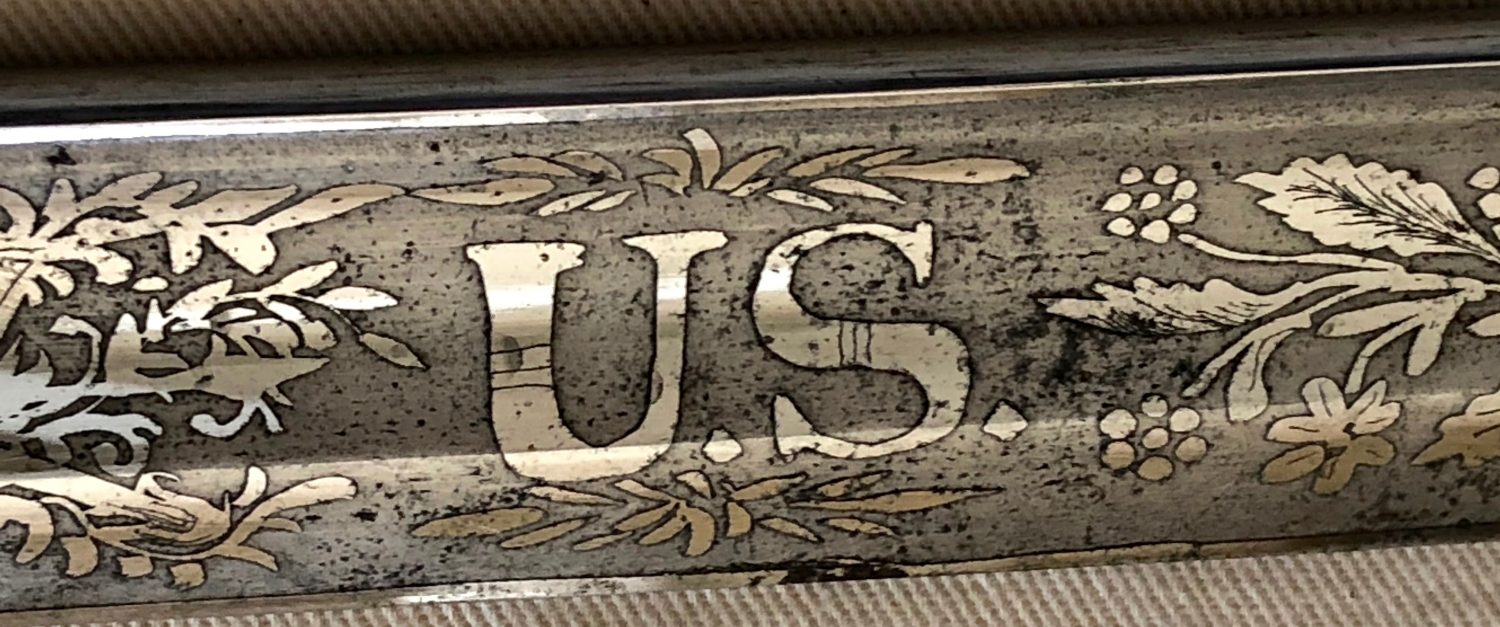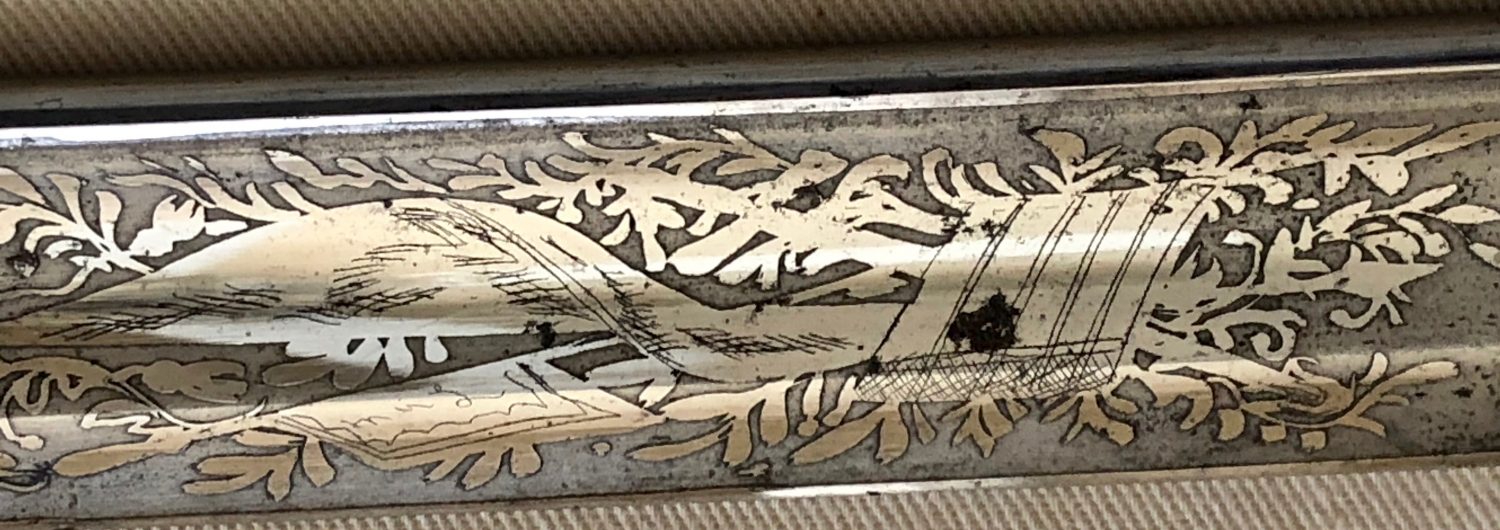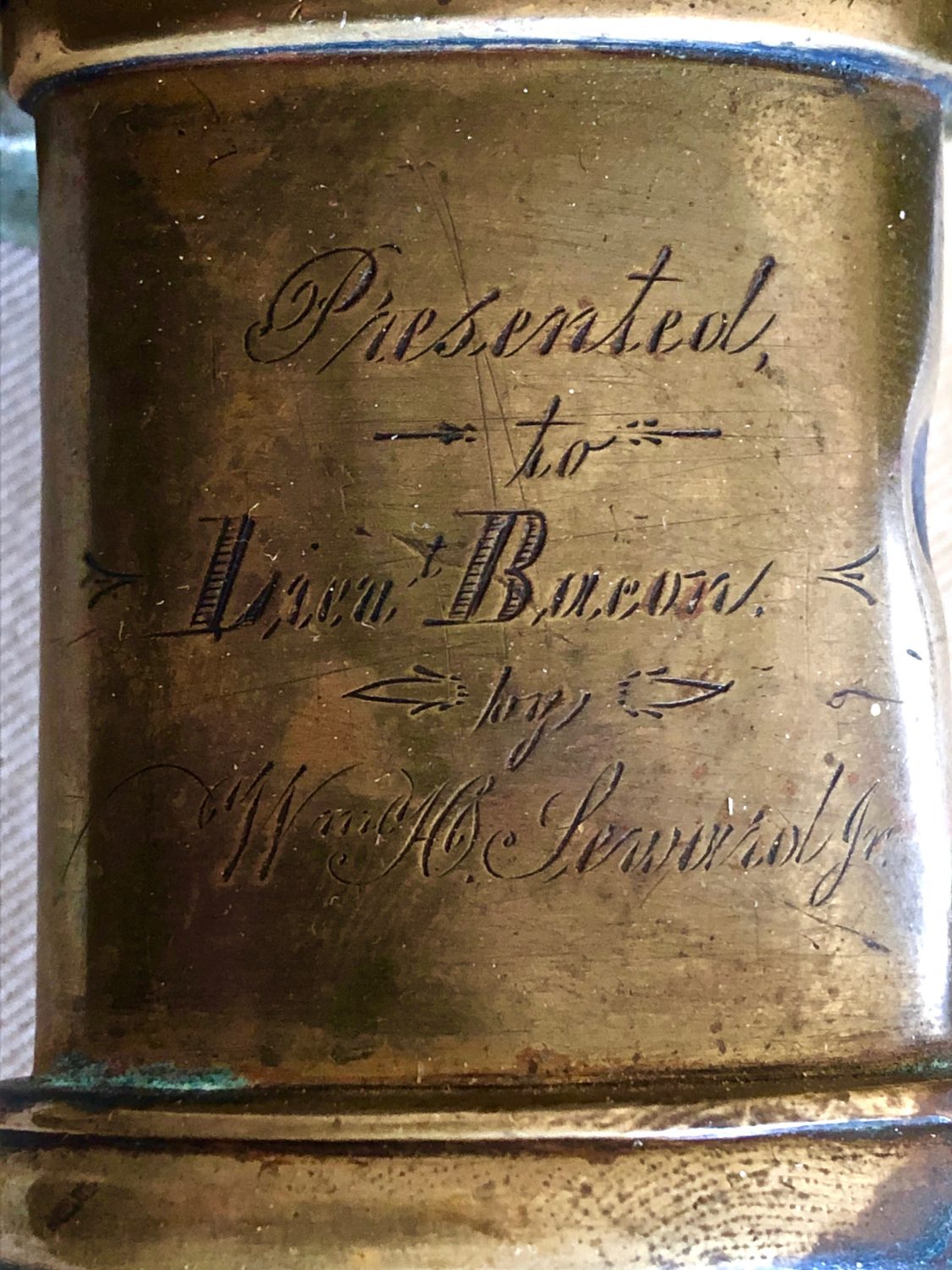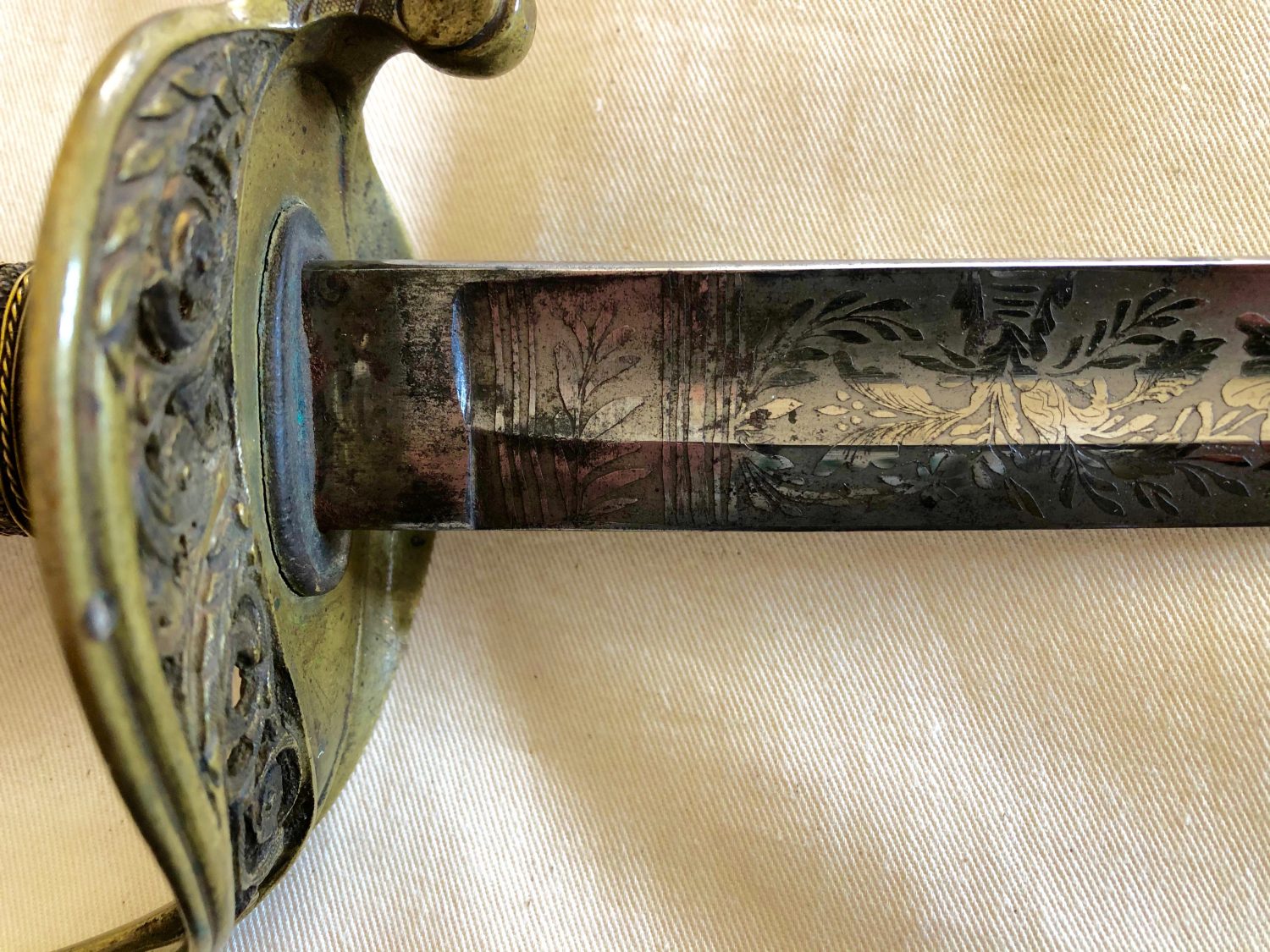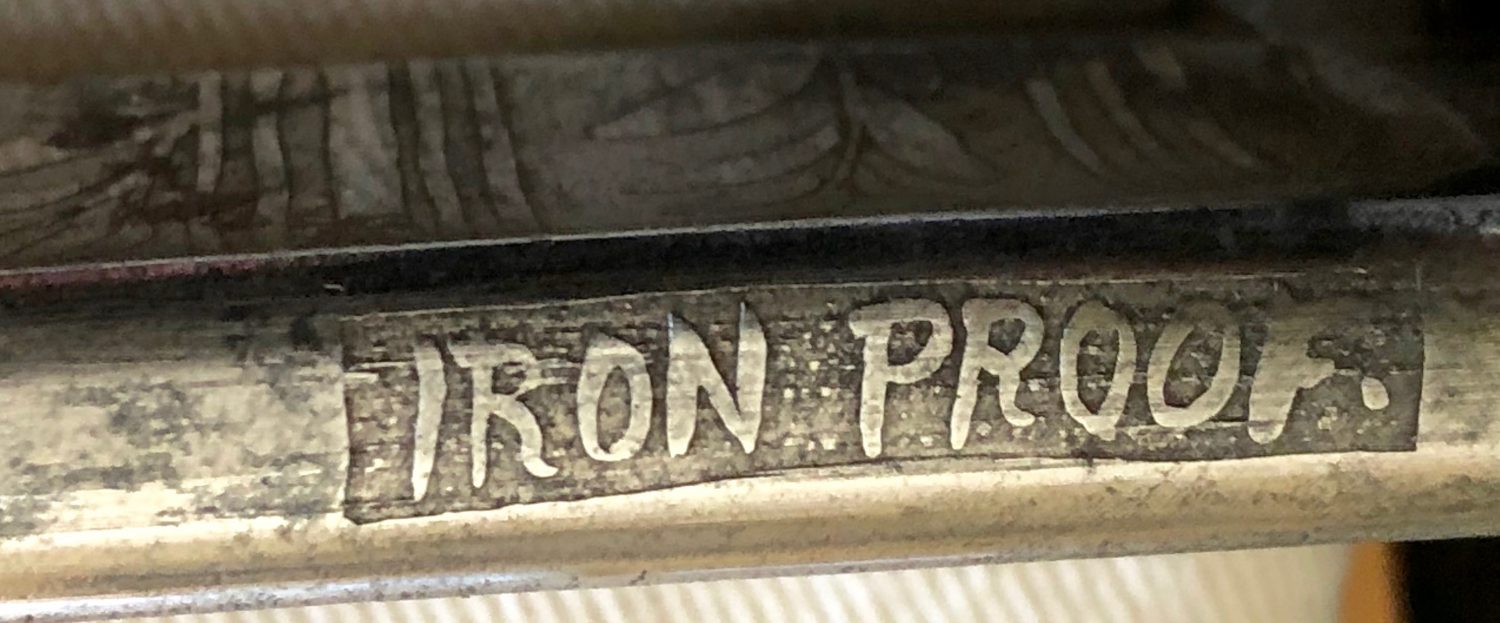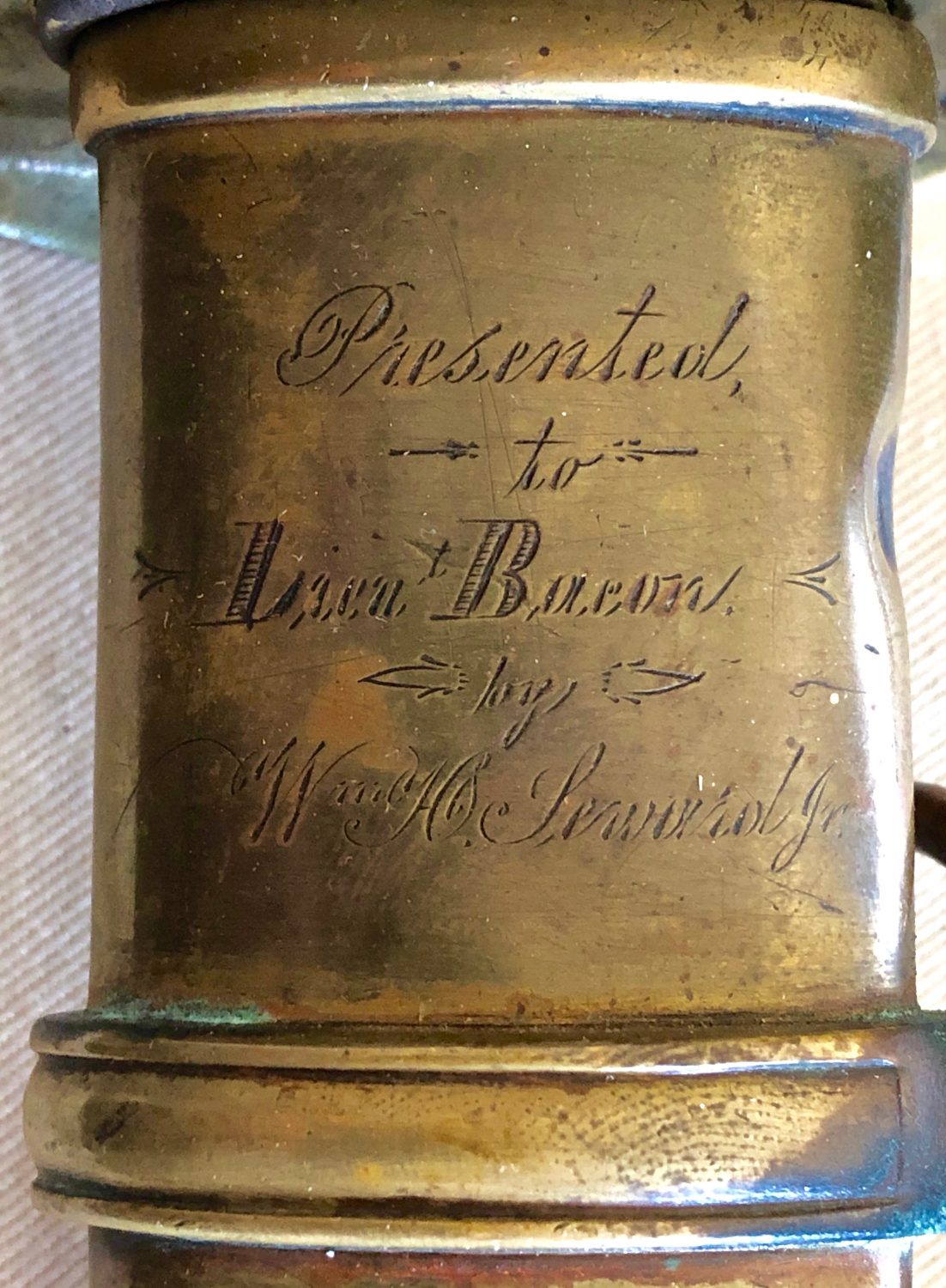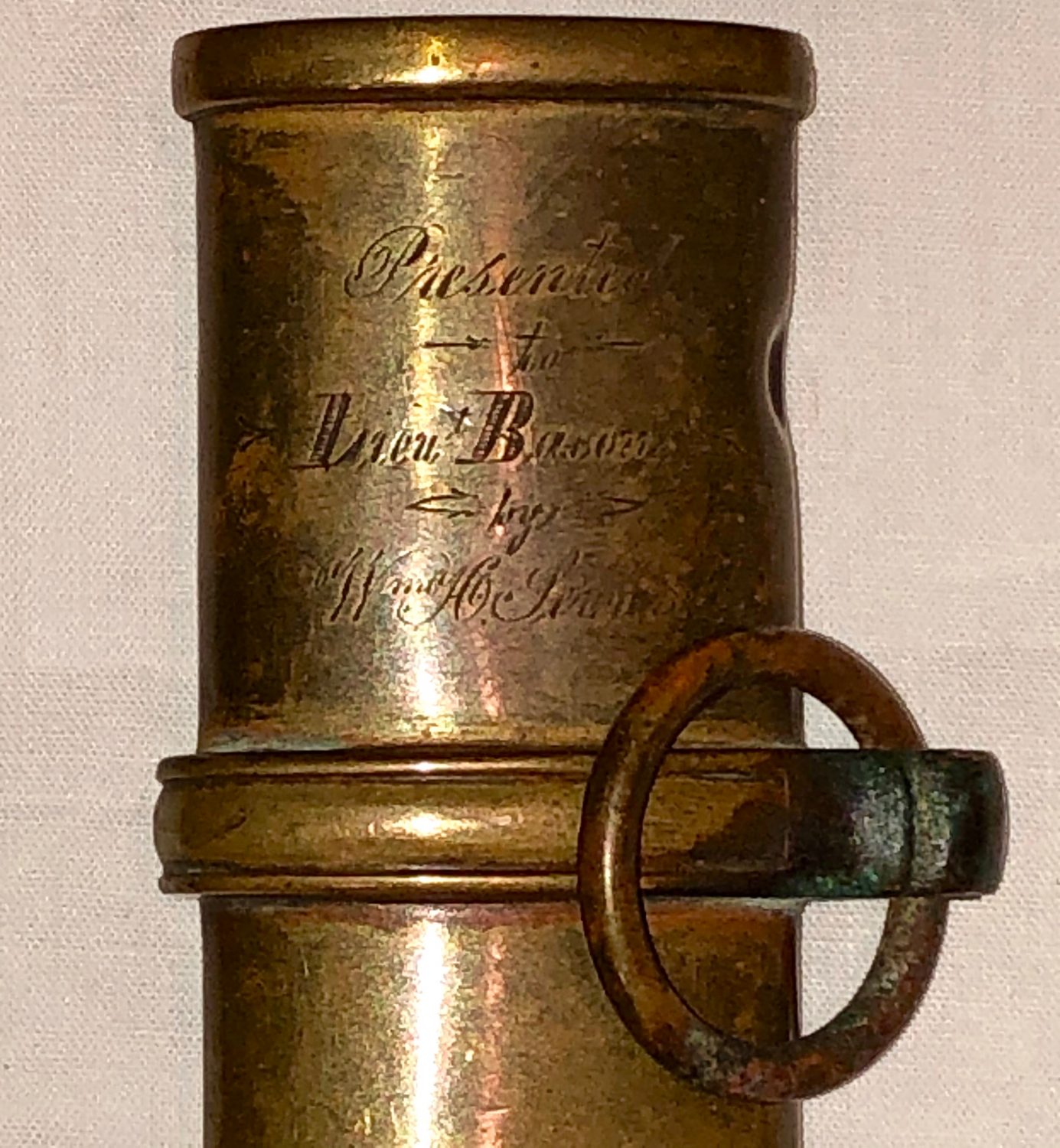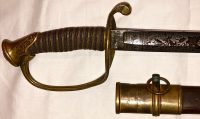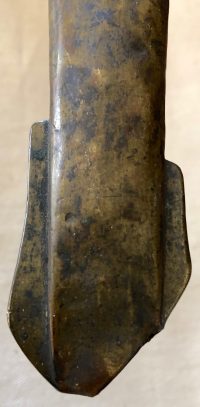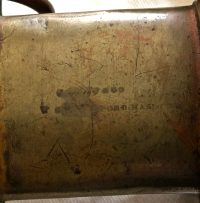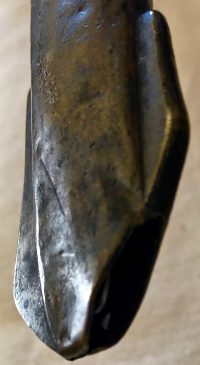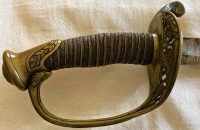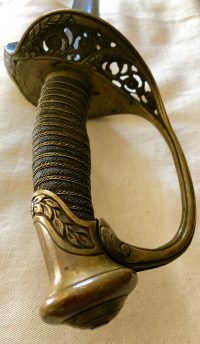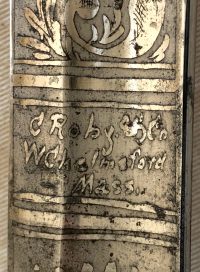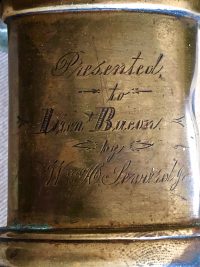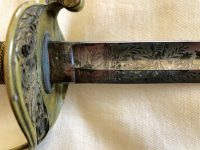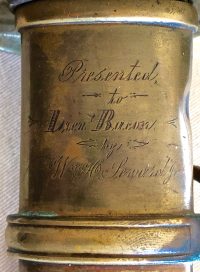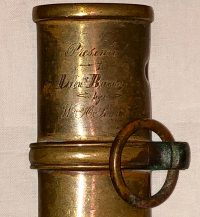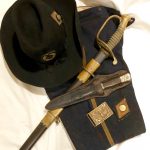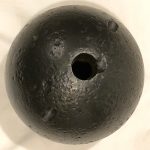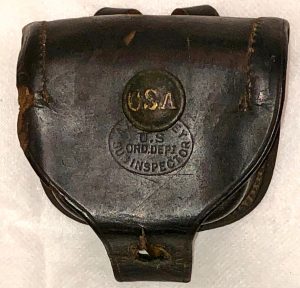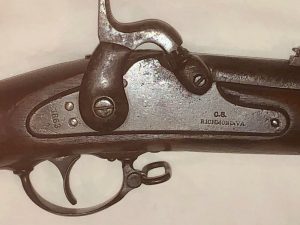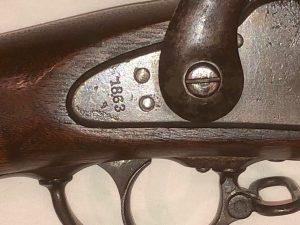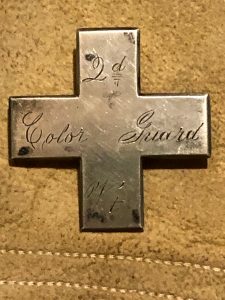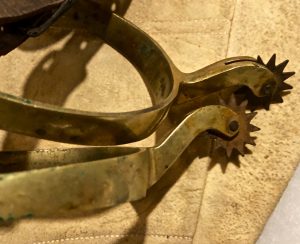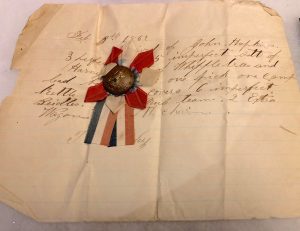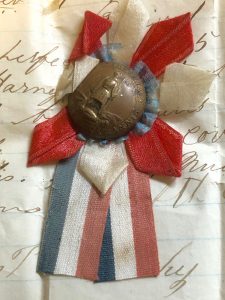Inscribed M1850 Foot Officers’ Sword – Wm. H. Seward, Jr. 9th NY Heavy Artillery
SOLD
Inscribed Presentation M1850 Foot Officers’ Sword – Wm. H. Seward, Jr. 9th NY Heavy Artillery – This Model 1850 Foot Officers’ sword, a fine example of an upper echelon Roby made sword, was presented by Secretary of State William Seward’s son, William, Jr., to a fellow officer, Lt. George W. Bacon, in the 9th New York Heavy Artillery. William Seward, Jr. would remain with the New York heavy artillery unit throughout the war and participate in combat during the Overland Campaign in 1864, at the rank of Colonel. He was wounded at the Battle of Monocacy and promoted to the rank of Brigadier General in September of 1864. George Bacon was commissioned as a 1st Lieutenant in Co. F of the 9th NY Heavy Artillery in August of 1862 and was discharged in February, at the rank of Captain, in February of 1864. Bacon’s regiment served in the forts surrounding Washington, DC. This sword is a good example of the M1850 Foot Officers’ sword, but exhibiting some important, additional aspects – manufactured and marked, as such, on the blade (etched) and stamped (on the upper sword mount) with “C.R. Roby / CHELMSFORD, MASS.”; the blade is highly and attractively etched with patriotic, decorative elements, retaining a high degree of “frosting”; the obverse of the sword mount is engraved in a manuscript style with: “Presented / to / Lieut Bacon. / by / Wm. H. Seward Jr.” The sword proper remains in overall very good condition; the ray fin grip is strong, as is the brass, twisted wired wrap; the leather scabbard is in good condition, with a weak area near the top of the drag; the drag itself is complete, but well worn on both sides of the end. This sword is significant as it was presented by the son of Secretary of State William Henry Seward, Sr., and it is a fine example of a rarely encountered Roby “high end”, marked officer’s sword.
George W. Bacon
| Residence Auburn NY; 30 years old. Enlisted on 8/22/1862 at Auburn, NY as a 1st Lieutenant. On 8/22/1862 he was commissioned into “F” Co. NY 9th Heavy Artillery He was discharged for disability on 8/15/1864 Promotions: * Capt 2/20/1864 (As of Co. D) Intra Regimental Company Transfers: * 2/20/1864 from company F to company D Other Information: born 2/22/1832 Member of GAR Post # 37 (Charles H. Seward) in Auburn, NY died 5/22/1884 Buried: North Street Cemetery, Auburn, Cayuga Co., NY Federal Pension Information: He applied for a pension on 7/5/1872 application # 176,887 His Widow (Jane A Bacon) applied for a pension on 6/5/1884 application # 316,368 After the War he lived in Auburn, NY |
9th NY Heavy Artillery
( 3-years )
| Organized: Auburn, NY on 12/19/62 Mustered Out: 7/6/65 at Washington, DCOfficers Killed or Mortally Wounded: 6 Officers Died of Disease, Accidents, etc.: 3 Enlisted Men Killed or Mortally Wounded: 198 Enlisted Men Died of Disease, Accidents, etc.: 254 (Source: Fox, Regimental Losses) |
| From | To | Brigade | Division | Corps | Army | Comment |
| Aug ’62 | Oct ’62 | Artillery | Defenses North of Potomac | Whipple’s Command | Military District of Washington | |
| Oct ’62 | Feb ’63 | 2 | Defenses North of Potomac | Whipple’s Command | Military District of Washington | |
| Feb ’63 | Apr ’64 | 2 | Defenses North of Potomac | 22 | Department of Washington, D.C. | |
| Apr ’64 | May ’64 | 3 | Defenses North of Potomac | 22 | Department of Washington, D.C. | |
| May ’64 | Jun ’64 | Artillery | 6 | Army of Potomac | Check (2nd Battn) | |
| Jul ’64 | Sep ’64 | 1 | Defenses North of Potomac | 22 | Department of Washington, D.C. | 4 Cos. |
| Jul ’64 | Jun ’65 | 1st Separate | 8 | Middle Department | Det. | |
| Aug ’64 | Dec ’64 | 2 | 3 | 6 | Army of the Shenandoah |
New York
NINTH REGIMENT OF ARTILLERY (HEAVY).
Second Auburn Regiment; Cayuga and Wayne County Regiment.
(Three Years)
| The organization of this regiment was determined August 8, 1862, and Col. Joseph Welling received, August 12, 1862, authority to recruit the regiment in the, then, 25th Senatorial district of the State. September 29, 1862, this regiment was designated the 138th Regiment of Infantry. It was organized at Auburn, and there mustered in the service of the United States for three years, September 8 and 9, 1862. It was converted into an artillery regiment December 9, 1862, and designated, December 19th, the 9th Regiment of Artillery. February 5, 1863, the 22d N. Y. Volunteer Battery was, by the War Department, transferred to the regiment as Company M. Company L was organized at Albany and there mustered in the United States service for three years between November 4 and December 9, 1863. The companies were recruited principally: A at Red Creek, Huron, Wolcott and South Butler; B at Williamson, Ontario and Walworth; C at Conquest, Cato and Victory; D at Lyons, Sodus, Huron, Rose and Galen; E at Venice, Scipio, Auburn, Moravia, Miles, Summerhill, Fleming and Montezuma; F at Geneva, Auburn, Owasco, Sennett, Niles, Lansing, Mentz and Aurelius; G at Wolcott, Savannah, Butler, Sterling, Huron and Rose; H at Galen, Butler, Savannah, Rose and Victory; I at Auburn, Owasco and Sennett; K at Clyde, Ira, Lyons, Wolcott, Galen, Williamson and Ontario; L in Albany county; and M at Batavia, Bergen, Bethany, Alexander, Darien and Oakfield. The regiment (ten companies) left the State September 12, 1862, and served as infantry and heavy artillery in the defenses of Washington, D. C., north of the Potomac, from September, 1862; in the 2d, and later 3d, Brigade, Haskins’ Division, 22d Corps, from February, 1863; the 1st and 3d Battalions in the 2d Brigade, 3d Division; the 2d Battalion in the Artillery Brigade, 6th Corps, Army of the Potomac, from May 25 and 31, 1864, respectively; the 2d Battalion in 1st Brigade, Hardin’s Division, 22d Corps, at Washington, D. C., from July 10, 1864; in Colonel Keim’s Provisional Brigade, from September 23, 1864; all in the 2d Brigade, 3d Division, 6th Corps, Army of the Potomac, from October 3, 1864; with the Army of the Shenandoah from October, 1864, and with the Army of the Potomac, from December, 1864. It was honorably discharged and mustered out, under Col. James W. Snyder, July 6, 1865, at Washington, D. C., the men not entitled to be discharged then having been formed into four companies and transferred, June 27, 1865, to the 2d N. Y. Volunteer Artillery as Companies I, K, L and M of the latter. |
William H. Seward Jr.
| Personal details | |
| Born | William Henry Seward Jr. |
| Died | April 29, 1920 (aged 80) Auburn, New York |
| Resting place | Fort Hill Cemetery, Auburn, New York |
| Spouse(s) | Janet MacNeil Watson |
| Children | 3 |
| Parents | William H. Seward Frances Adeline Miller |
| Military service | |
| Allegiance | United States of America Union |
| Branch/service | United States Army Union Army |
| Years of service | 1862–1865 |
| Rank | Brigadier General |
| Commands | 9th New York Heavy Artillery Regiment |
| Battles/wars | American Civil War |
William Henry Seward Jr. (June 18, 1839 – April 29, 1920) was an American banker and brigadier general in the Union Army during the American Civil War. He was the youngest son of William Henry Seward Sr., the United States Secretary of State under Abraham Lincoln and Andrew Johnson.
Early life
Seward was born in Auburn, New York. His father, William Henry Seward Sr., had just taken office as Governor of New York when he was born, and his mother, Frances Adeline Seward, was the daughter of Judge Elijah Miller, a law partner of Seward who had built the family home in Auburn in 1816. His elder brothers were Augustus Henry Seward, a brevet colonel in the Paymaster Corps, and Frederick William Seward, who served as Assistant Secretary of State to his father.
Career
Banking
Educated at home, Seward became interested in finance and later started a partnership with Clinton McDougall, was private secretary to his father, then a U.S. Senator from New York, in 1860, and opened a private bank in Auburn in 1861. He left banking on August 22, 1862, to join the Union Army in the U.S. Civil War.
Military career
Seward was appointed lieutenant colonel of New York’s 138th Infantry Regiment, which became the 9th New York Heavy Artillery Regiment in December 1862. The regiment served in the defenses of Washington, D.C. until it was converted back to an infantry regiment and sent to the Army of the Potomac because of the losses sustained by that army in the Overland Campaign. After fighting at the Battle of Cold Harbor,[2] Seward was appointed colonel of the regiment on June 10, 1864.
A few weeks after Seward’s promotion to colonel, his regiment was sent north to meet the threat to Washington, D.C. posed by Confederate Lieutenant General Jubal Early’s Valley Campaigns of 1864. Seward was slightly wounded in his arm and suffered a broken leg when his horse fell on him after the horse was shot at the Battle of Monocacy on July 9, 1864. He was promoted to brigadier general on September 13, 1864, and in January 1865 was assigned to command a brigade in the Department of West Virginia, which he did until April 1865. He was thereafter known within his family as “The General”. Seward commanded the 3rd Division for 6 days after Confederate partisan rangers captured Brigadier General George Crook on February 20, 1865.
Post-military career
Seward resigned his commission on June 1, 1865. After the war, Seward returned to banking and lived with his wife in the family homestead in Auburn, New York. In addition to his banking career, he engaged in politics, charitable work, and patriotic and historic societies and he became a director of several corporations. In 1886, he was elected as a companion of the New York Commandery of the Military Order of the Loyal Legion of the United States and was assigned insignia number 4696.
Personal life
Seward married Janet MacNeil Watson (1839–1913), with whom he had three children:
- Cornelia Margaret Seward Allen (1862–1921)
- William Henry Seward III(November 10, 1864 – February 16, 1951)
- Frances Janet Seward Messenger (1880–1957)
William Henry Seward Jr. died in Auburn, New York, on April 26, 1920, at the age of 80, and is buried in Auburn’s Fort Hill Cemetery,[1] next to his father.
William Seward, Jr. and the Battle of Monocacy
In the summer of 1864, John W. Garrett, President of the Baltimore & Ohio railroad, came to see General Lew Wallace. Mr. Garrett expressed concern for the safety of Washington (as well as his railroad). His personnel were reporting detachments of Confederate troops in the Shenandoah Valley and, according to him, such appearances were precursors of trouble. General Wallace decided to go to the western limit of his command, the Monocacy River, southwest of Frederick, Maryland. Upon his arrival at the blockhouse guarding the rail junction (Monocacy Junction) he found the country alive with rumor. A Confederate army, reported to be between 5,000 and 35,000 men strong, was thought to have crossed the Potomac River on the 2nd or 3rd of July. Its exact whereabouts and destination were both unknown. The civilians that General Wallace sent to gather information were turned back by rebel cavalry at every pass in the mountains west of Frederick. General Wallace believed this cavalry was screening a larger army.
Two miles north of the junction, a stone bridge called the Jug Bridgecrossed the Monocacy, carrying the National Road that led to Baltimore. At the junction there was an iron railroad bridge and, a few hundred yards southwest of it, the wooden covered bridge of the Georgetown Pike, the road to Washington. Any invading army intent on Washington or Baltimore would have to come this way. After brief consideration, General Wallace believed that Washington was the objective. He began putting men in place.
On July 9, 1864, 6,500 troops under the command of General Wallace met 14,000 battle–hardened veterans of the Army of Northern Virginia, commanded by General Jubal Early, on the farm fields near Monocacy Junction. Confederate troops held the field at day’s end, but Wallace and his men had delayed them long enough that reinforcements ultimately sent by Union General-in-Chief U.S. Grant would reach the lightly-defended U.S. capital just in time. Early’s plans to capture Washingtonwere quashed. The battle of Monocacy is now known as the “battle that saved Washington.”
General Grant later wrote that Wallace had done more for the cause by losing this battle than many generals had accomplished by winning.
As the Battle of Monocacy loomed, the city of Washington panicked. One of the men in Wallace’s small army was Colonel William Seward, son of Lincoln’s Secretary of State, William Henry Seward, and the commander of the hard-fighting Ninth New York Heavy Artillery. Seward’s regiment was in the middle of the Monocacy battle and according to Wallace’s official report the Ninth New York had 102 killed and wounded with 99 missing for a total of 201 casualties. Seward’s family, in Washington, received continuing reports from the battlefield and was well aware of Wallace’s valiant defense but ultimate defeat.
The Secretary of State stayed at the War Department reading telegrams coming in from the battle until almost midnight. He had just returned home when Secretary of War Edwin Stanton arrived at the Seward residence to tell the family that there were reports that young William was wounded and taken prisoner. Colonel Seward’s brother, Augustus, left early the next day to go to Baltimore in an effort to ascertain the truth of the rumors. Based on reports he could gather, Augustus determined that his brother had been wounded, but not captured—although his whereabouts were unknown in the panic and chaos that was gripping both Washington and Baltimore.
By that evening there was a telegram at the Seward home from General Wallace: “I have the pleasure of contradicting my statement of last night. Colonel Seward is not a prisoner, and I am now told he is unhurt. He behaved with rare gallantry.” While Colonel Seward was reported safe on July 10, Washington definitely was not—Jubal Early’s veterans were marching on the city. On July 11, Early’s army arrived in front of Ft. Stevens, the northernmost fort in Washington’s defensive chain. Early could see the flag flying on the dome of the U.S. Capitol.
The city was in real jeopardy–Grant’s reinforcements had not yet arrived–but luck was on the Union side because Early delayed his attack. Grant’s reinforcements arrived on the night of the 11th and battled with Early’s men on July 12. During this fighting, President Lincoln arrived at Ft. Stevens and insisted on watching the action from the ramparts. He was thus exposed to Confederate sharpshooters, who killed an officer standing nearby, whereupon the President was convinced to move off the walls.
As it turned out, Wallace’s information relayed to the Seward family was still not correct. Colonel Seward had in fact been injured. He suffered a slight wound to his arm and broke his leg when his horse was shot and fell on him during the battle. Seward was unable to walk off the battlefield and only escaped capture when he found a mule and, using his silk handkerchief as a bridle, was able to ride off the field ahead of the Confederates. Within eight weeks Seward was promoted to brigadier general and served throughout the remainder of the war. A banker before the war, General Seward returned to a successful career in banking after his time in the military. He followed politics, supported charitable causes, served as a director for a number of corporations, and was involved in historical and patriotic societies until his death in 1920, over 50 years after Lew Wallace’s battle that saved Washington—a battle that directly affected the outcome of the Civil War and likely changed the history of the nation.
Many years later General Wallace encountered one of the Confederate commanders, J. B. Gordon, at a White House reception. Gordon told Wallace he was the only Yankee who ever whipped him. Wallace replied that, in the end, his men ran from the field. “In that sense you are right,” Gordon countered, “but you snatched Washington out of our hands.”
Sources: Shadow of Shiloh, Gail Stephens, Indiana Historical Society Press, 2010
Seward, Lincoln’s Indispensable Man, Walter Stahr, Simon & Schuster, 2012
9th New York Heavy Artillery Regiment
9th New York Heavy Artillery Flank Marker
| 9th New York Heavy Artillery | |
| Active | September 6, 1862 – July 6, 1865 |
| Disbanded | July 6, 1865 |
| Country | United States |
| Allegiance | Union |
| Branch | Artillery |
| Type | Heavy Artillery |
| Role | Heavy Artillery and Infantry |
| Size | 3,227 (Total Enrollment) |
| Part of | XXII Corps and VI Corps |
| Garrison/HQ | Fort Kearney, Fort Mansfield, Fort Simmons, Fort Bayard, Fort Gaines, Fort Foote, Fort Reno, Fort Summner, Fort Thayler, Fort Fisher (Petersburg),[1] other forts |
| Nickname(s) | Second Auburn Regiment, Second Wayne and Cayuga Regiment, Seward’s Pets,[2] Life Insurance Regiment |
| Patron | Secretary of State William H. Seward[3] |
| Colors | Red and gold |
| March | Belle Brandon[4][5] |
| Rifle | Smooth-bored Muskets, model 1842 (.69 caliber)[6] |
| Engagements | Overland Campaign |
| Battle honours | Cold Harbor, Petersburg, Monocacy, Opequon, Cedar Creek, Petersburg, April 2d, and Sailor’s Creek[7] |
| Commanders | |
| Regimental Commander | Colonel James W. Snyder (November 28, 1864 – July 6, 1865) |
| Regimental Commander | Colonel Edward P. Taft (May 21, 1864 – September 15, 1864) |
| Regimental Commander | Colonel William H. Seward Jr. (May 21, 1864 – September 15, 1864) |
| Regimental Commander | Colonel Joseph Welling (August 22, 1862 – May 20, 1864) |
| Notable commanders |
Colonel William H. Seward Jr. |
Company M in 1865 in one of the Washington, DC forts
The 9th New York Heavy Artillery Regiment was a regiment in the American Civil War. It was one of the nine Heavy Artillery regiments to suffer over 200 killed; it is also mentioned as one of Fox’s 300 Fighting Regiments[
History
Formation and Defences of Washington, D.C.
The regiment was originally mustered in on September 8, 1862, as the 138th New York Infantry Regiment, was quickly taken to Washington D.C. to be used in the defenses of the nation’s capital. On December 19, 1862, it was redesignated as the 9th New York Heavy Artillery Regiment. On February 5, 1863, an additional Company M was created within the regiment with the transfer of the 22d N.Y. Volunteer Battery. Company L was organized in Albany between November 4 and December 9, 1863.
Amongst the regimental commanders, William H. Seward Jr. stands out as he is the son of then-Secretary of State William H. Seward. Due to this, William H. Seward visited the regiment often, and as a consequence, it gained the nickname, “Seward’s Pets.”[
The Regiment was divided into three battalions. After the formation of the regiment, its duties were the protection of the capital. While there, it built and garrisoned Fort Mansfield, Fort Bayard, Fort Gaines, and Fort Foote until spring, 1864. A letter to the editor of the Dem. Press gives the condition of the regiment on March 11, 1864, about two months before the 9th began combat operations. The letter is taken from the New York State Military Museum and Veterans Research Center[
The 9th Artillery—their number, services, condition, &c.
Hospital Dep’t, 9th N. Y. Artillery,
Fort Mansfield, Md., March 11, ’64.
TO THE EDITOR DEM. PRESS:—There has been a great deal said in Lyons and vicinity respecting the number of men in the Ninth Artillery–the number ranging, as stated by different reports, at all points from eighteen hundred up to three thousand. For the information of those who are not posted, I will state that the aggregate number in the Report which was this morning sent to Brigade Headquarters was 1,674; of this number 79 are recruits who have lately arrived, and are not yet assigned to companies. The number of men in each Company is as follows: Co. A, 127; B, 147; C, 99; D, 121; E, 91; F, 132; G, 102; H, 146; I, 148; K, 147; L, 147; M, 137. These numbers, of course, do not include commissioned officers.
Allow me, also, to disabuse the minds of your readers in regard to another point. This regiment has been styled the “pet Regiment,” Life Insurance Regiment, &c. Probably there is not a Regiment in the Defences of Washington that has done more fatigue duty and real hard work than the Ninth. If it has not fought as many battles as some Regiments, the work which it has done has been as valuable to the Government. Besides building Forts Simmons, Mansfield, Bayard, Gaines and Foote, (one of the largest in the Defences,) it helped build Forts Reno and Sumner, two very large Forts, and has dug miles upon miles of rifle pits and built miles upon miles of Military roads and in addition chopped over more land then a good many of the farms in Wayne County put together would compose. Notwithstanding this vast amount of “drill” with the pick, shovel and axe, Col. Welling has brought the Regiment to as high a state of discipline as can be desired. If the boys have not worked, who has?
Yours, W. L. G.
Combat Operations
Overland Campaign
In May 1864, Lt. General Ulysses S. Grant took command of the Union Army, embarking on an aggressive campaign, called the Overland Campaign, against the south. Due to heavy casualties suffered by Union Army, more troops were needed to embark on the campaign. To achieve this, General Grant ordered most of the troops defending the capital, including the 9th New York Heavy Artillery, to the front to increase troop numbers.[13] They would now be Heavy Artillery in name only, donning their rifles and assuming the duties of infantrymen. Two battalions, 1st and 2nd, of the 9th joined the VI Corps and the Army of the Potomac as infantry, while one, the 3rd battalion (Cos. C, I, L, and F), joined the Artillery Brigade. They numbered 1,944 men on May 26, 1864, as reported by Maj. Charles Burgess, before commencement of combat operations.[14]
Battle of Cold Harbor
The 9th New York Heavy Artillery joined the VI Corps on the banks of North Anna River on May 26, 1864, and then marched to the Pamunkey during the nights of May 27 and 28. From there, it departed for Cold Harbor on May 29, guarding the wagon train along the way, where it saw its first offensive action on June 1, 1864, at the Battle of Cold Harbor, where the brigade they were part of charged at 6 pm and captured several hundred prisoners, and also managed to hold against several counterattacks on June 2.[15] It also participated in the major attack on June 3, being placed second and third in the line of battle in Keifer’s Brigade (110th Ohio and 122nd Ohio Infantry in the first line of battle, and 6th Maryland, 126th Ohio, and 138th Pennsylvania Infantry in the fourth line) in the 3rd Division, where they were ordered at 6 am to proceeded to advance 200 yards, where upon they entrenched under heavy fire.[16] Over the course of the Battle of Cold Harbor the 9th numbered 43 killed and mortally wounded, 99 wounded, and 6 missing, for a total of 148.
